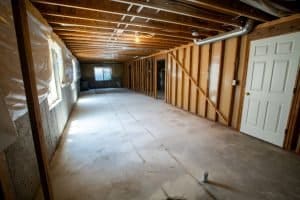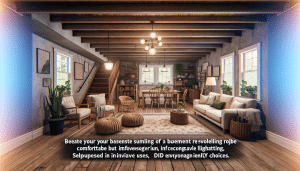Basements in Salt Lake City are kind of a secret weapon—extra square footage sitting there, just waiting to be turned into a rentable apartment, a guest suite, or a really nice teen hangout. But there’s one piece people skip until a city inspector says “nope”: ***egress windows***. They’re not just a code thing; they’re a safety, light, and livability thing. And if you’re finishing a basement to rent out, you absolutely can’t wing it.
Contents
- 1 So…what is an egress window, really?
- 2 What Salt Lake City and Utah typically expect
- 3 “But my basement is below grade…”
- 4 Types of egress windows that work well in basements
- 5 Let’s talk structure—cutting into concrete walls
- 6 Light, air, and “it doesn’t feel like a basement anymore”
- 7 How egress windows affect rental potential
- 8 What it costs (and what affects the price)
- 9 Should you add more than one?
- 10 Ready to make your basement rentable?
So…what is an egress window, really?
Let me explain. An egress window is simply a window big enough for someone to climb out of—and big enough for a firefighter to climb into. That’s it. It’s an escape route. Basements only have one obvious way out (the stairs), so building codes require another way out in case that stairway is blocked.
Here’s the thing: a basement bedroom in Utah that doesn’t have an egress window isn’t technically a legal bedroom. You can build a beautiful framed room, run electrical, hang drywall, even stage it on Zillow—but without an egress, it’s just “a room.” That matters if you’re renting, selling, or getting appraised.
What Salt Lake City and Utah typically expect
Utah cities, including Salt Lake City, follow versions of the International Residential Code (IRC) for emergency escape and rescue openings. Local amendments can change small details—so always check Salt Lake City’s current building info or talk to a licensed basement finisher—but the general standards stay pretty similar across the Wasatch Front.
Most egress windows need to check these boxes:
- Minimum open area: at least 5.7 square feet (5.0 sq. ft. if it’s at grade level)
- Minimum opening height: around 24 inches
- Minimum opening width: around 20 inches
- Maximum sill height: the bottom of the opening usually has to be 44 inches or less from the finished floor
Why all those numbers? Because in an emergency, no one has time to twist sideways through a tiny slider. The opening has to be usable—by kids, guests, tenants, and, yes, a firefighter in gear.
“But my basement is below grade…”
Yep—most are. That’s where window wells come in.
When your window is below ground, you dig out a space on the outside and install a window well. That well has to be wide enough, deep enough, and strong enough to let someone get out. If it’s too deep, it also needs a built-in ladder.
What your window well should have
- Clear floor space: usually at least 9 square feet—think 3’ x 3’
- Ladder or steps: if the well is deeper than 44 inches, you need a permanent ladder
- Drainage: super important in Utah—snowmelt + bad drainage = basement aquarium
- Cover (optional but smart): a code-approved cover keeps kids, snow, and leaves out, but still has to open easily
If you’re renting the space, make sure the well isn’t scary. Seriously. A rusted corrugated well with spiders and half a lawnmower in it? Tenants won’t love that. A clean, wide, rock-filled well with a clear cover? Much better.
Types of egress windows that work well in basements
Not every basement window style works. Some look nice but don’t open enough. Here are the ones that usually make sense:
1. Casement egress windows
These are the ones that swing out like a door. They’re popular for basements because they can provide a large opening without needing a huge wall space. You crank them open fast—very tenant-friendly.
2. Sliding egress windows
These work, but only if the opening size hits code when the sash is slid open. A lot of people assume a wide slider is fine, but if half the window doesn’t open, the clear area might not meet the square-foot requirement. That’s why ordering “just a big window” from a box store doesn’t always solve it.
3. Awning windows
These open from the bottom. They’re nice for ventilation but usually don’t qualify for egress in a basement because the sash blocks part of the opening. So they’re good add-ons, not your main escape window.
Let’s talk structure—cutting into concrete walls
In a lot of Salt Lake basements—especially in older neighborhoods like Sugar House, Millcreek, and the east bench—you’re dealing with concrete or block foundation walls. Enlarging a basement window here isn’t just “grab a saw and go.” You’re cutting into a load-bearing wall. That means:
- You need the opening sized correctly on the plans
- You need a proper header and support
- You may need a permit (most times, yes)
- You absolutely should waterproof around the new opening
Honestly, this is where DIY starts to wobble. Cutting concrete, setting the well, tying into drainage—it’s doable, but for a rentable basement, you want it to look like it came that way from the builder.
Light, air, and “it doesn’t feel like a basement anymore”
This is the part I love. Everyone talks about code, but here’s the secret: a big egress window makes a basement feel like a real floor of the house. Natural light changes everything—paint colors look right, tenants stay longer, and the space stops feeling like a bunker.
If you’re finishing for Airbnb, a college renter, or family, that extra daylight just photographs better. One well-placed egress can do more for perceived value than fancy trim or expensive carpet.
Pro tip for Utah basements: pair your egress window with light-colored window wells (galvanized or stone), and bounce light in. If you want to get fancy, install a stepped well with stone—way more high-end than a plain corrugated ring.
How egress windows affect rental potential
You know what? This is where the money piece sneaks in.
Salt Lake City renters are picky right now—especially basement renters. They don’t want “dark.” They don’t want “how do I get out in a fire?” And the city doesn’t want an unregistered basement suite. An egress window checks all three: safety, habitability, and compliance. That makes your basement easier to rent and easier to insure.
Plus, when you eventually sell, you can say: “Yes, that’s a legal basement bedroom.” That’s a better listing.
What it costs (and what affects the price)
I won’t throw numbers since every basement is different—corner lot in Daybreak vs. 1950s bungalow in South Salt Lake is a huge swing. But generally, costs go up when:
- You have to cut into concrete foundation
- The window well has to be extra deep
- You need drainage tied to footing or sump
- You want a premium finish (stone well, metal cover, casement with grids)
Costs go down when the opening is already there and you’re just enlarging slightly or replacing an old small window with a code-size unit.
Should you add more than one?
Sometimes—yes. If you’re doing a full basement finishing project in Salt Lake City and planning two legit bedrooms, you’ll typically add an egress for each sleeping room. Some owners even add one in the main family room to make the whole basement safer and brighter.
Ready to make your basement rentable?
If you’re finishing a basement in Salt Lake City and you want it to pass inspection, look amazing, and make sense for a long-term tenant, start with the egress window. We can look at your layout, tell you which wall makes the most sense, and handle the concrete, well, drainage, and finishing trims so it actually looks like part of the house—not an afterthought.
- By Phone: 801-515-3473
- By Form: https://utbasementfinishing.com/request-quote/#go
Call us, tell us what you’re building, and we’ll make sure the egress is right the first time.




